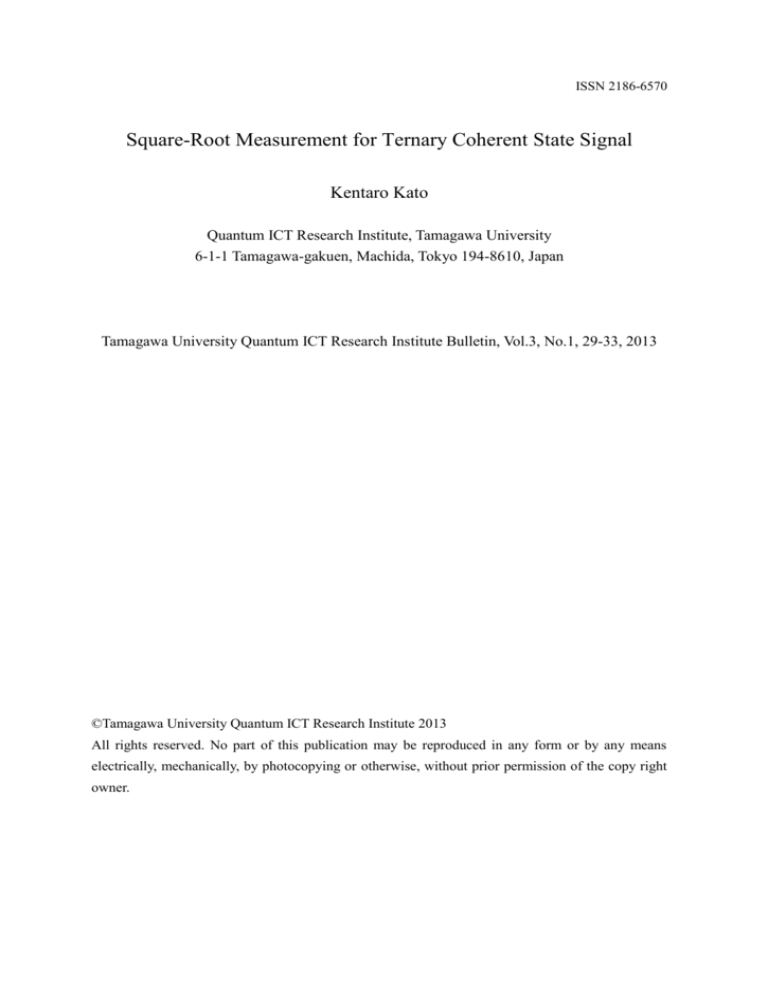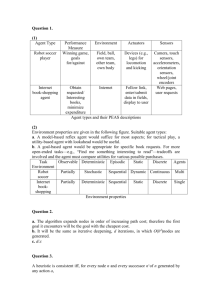
ISSN 2186-6570
Square-Root Measurement for Ternary Coherent State Signal
Kentaro Kato
Quantum ICT Research Institute, Tamagawa University
6-1-1 Tamagawa-gakuen, Machida, Tokyo 194-8610, Japan
Tamagawa University Quantum ICT Research Institute Bulletin, Vol.3, No.1, 29-33, 2013
©Tamagawa University Quantum ICT Research Institute 2013
All rights reserved. No part of this publication may be reproduced in any form or by any means
electrically, mechanically, by photocopying or otherwise, without prior permission of the copy right
owner.
Tamagawa University Quantum ICT Research Institute Bulletin
Vol.3 No.1 : 29_33 (2013)
29
Square-Root Measurement for Ternary Coherent
State Signal
Kentaro Kato
Quantum Communication Research Center,
Quantum ICT Research Institute, Tamagawa University
6-1-1 Tamagawa-gakuen, Machida, Tokyo 194-8610 Japan
E-mail: kkatop@lab.tamagawa.ac.jp
Abstract—The closed-form expression of the squareroot measurement for the ternary coherent state signal
{|0⟩, |α⟩, |−α⟩} is derived. Further, the optimal distribution
of the ternary coherent state signal that makes the squareroot measurement Bayes-optimal is also derived. From a
numerical analysis, it is shown that the average probability
of error obtained from the square-root measurement and the
corresponding optimal distribution provides a good lower
bound of the minimax value for the ternary coherent state
signal.
I. I NTRODUCTION
Quantum detection theory is one of fundamental tools
for evaluating the performance limit of optical digital
communication systems [1], [2]. When the probability
distribution of quantum state signals to be transmitted
from the sender is unknown at all, a better approach
for finding the minimum average probability of error
of the communication system under consideration is to
employ the quantum minimax strategy [3], [4], [5] rather
than the quantum Bayes strategy. The minimum average
probability of error in terms of the quantum minimax
strategy is called the minimax value. In general, analytical derivation of the minimax value for a given set
of quantum state signals is difficult. Although one can
use a numerical calculation procedure [6], finding the
minimax value with a required computational accuracy
will be not easy when the number of quantum state
signals becomes quite large. This motivates us to find an
appropriate quantity that behaves like an alternative to the
minimax value and is easy to calculate. For this purpose,
we focus attention on the square-root measurement [7],
[8], [9] because of its simple structure. According to the
literature [10], the square-root measurement for distinguishing linearly independent pure state signals becomes
Bayes-optimal with certain probability distribution that
is given by the diagonal entries of the square-root of
the Gram matrix formed by the state vectors of the
signals. From the definition of the minimax value, the
average probability of error obtained by the square-root
measurement for linearly independent pure state signals
and the corresponding optimal probability distribution
provides a lower bound for the minimax value in general.
In this study, we are aiming to investigate the tightness
of this lower bound for the minimax value. As the first
step to this aim, the square-root measurement for ternary
coherent state signal {|0⟩, |α⟩, |−α⟩} is considered in this
paper. In the context of the advanced optical modulation
formats for fiber-optic communication systems [11], this
type of ternary signal is actually used in some modulation techniques such as duobinary and alternate mark
inversion. Moreover, in the context of the optical reading
schemes or optical radar systems that are operated with
binary phase shift keying signal, this type of ternary
signal describes a situation that reflected signals from the
target randomly disappeared on the way to the receiver.
Taking the difficulty of estimation of the signal disappearance rate into account, the minimax approach to this
ternary signal is suitable for the right evaluation of its
error performance. Thus the error performance analysis
of the ternary coherent state signal itself is relevant to our
interest in developing design theory for practical quantum
communication systems, as well as the discussion on the
tightness of the lower bound for the minimax value of it.
The remaining part of this paper is organized as
follows. The column vector representation of the ternary
coherent state signal and the closed-form expression of
the corresponding square-root measurement are shown in
Section II, and the minimax case is reviewed in Section
III. Using the results of Sections II and III, numerical
comparison between the minimax value and the lower
bound obtained from the square-root measurement is
performed in Section IV, together with other two cases
that the uniform distribution of the signal is supposed,
and we summarize this paper in Section V.
II. S QUARE -ROOT M EASUREMENT FOR T ERNARY
C OHERENT S TATE S IGNAL
Let A = {0, +, −} be the alphabet of signaling
symbols. For each symbol, we set
�→ |ψ0 ⟩ = |0⟩,
“ + ” �→ |ψ+ ⟩ = |α⟩,
“0”
“−”
�→ |ψ− ⟩ = |−α⟩,
(1)
(2)
(3)
where |0⟩ is the vacuum state, and |±α⟩ are the coherent
states of light having amplitudes α > 0 and −α, respec-
30
tively. Here we define
|ϕ1 ⟩
|ϕ2 ⟩
|ϕ3 ⟩
=
=
=
c11 |ψ0 ⟩ + c12 |ψ+ ⟩ + c13 |ψ− ⟩,
c21 |ψ0 ⟩ + c22 |ψ+ ⟩ + c23 |ψ− ⟩,
c31 |ψ0 ⟩ + c32 |ψ+ ⟩ + c33 |ψ− ⟩,
with the coefficients
c11
c12 = c13
c21
c22
c23
c31
c32 = c33
=
=
=
=
=
=
=
(4)
(5)
(6)
0,
1
√
,
2(1 + κ4 )
0,
1
√
,
2(1 − κ4 )
1
−√
,
2(1
− κ4 )
√
1 + κ4
,
1 − κ2
κ
√
−
,
2
(1 − κ ) 1 + κ4
The eigenvalues of G are given by
(7)
where κ = exp[−|α| /2]. These vectors form an ordered
orthonormal basis, γ = {|ϕ1 ⟩, |ϕ2 ⟩, |ϕ3 ⟩}. By using this
orthonormal basis γ, the signal states can be represented
as
w
.
|ψ0 ⟩ = [|ψ0 ⟩]γ = 0 ,
(8)
x
y
.
|ψ+ ⟩ = [|ψ+ ⟩]γ = +z ,
(9)
0
y
.
|ψ− ⟩ = [|ψ− ⟩]γ = −z ,
(10)
0
2
where the entries are given by
√
2κ
√
w
=
,
4
1
+
κ
1 − κ2
,
x = √
√1 + κ4
1 + κ4
y =
√
,
√ 2
4
1−κ
z =
√
.
2
(11)
For the signal set {|ψ0 ⟩, |ψ+ ⟩, |ψ− ⟩}, the decision
vectors of the square-root measurement are written as
|d•0 ⟩
|d•+ ⟩
|d•− ⟩
=
=
=
−1/2
Ĝ
|ψ0 ⟩,
Ĝ−1/2 |ψ+ ⟩,
Ĝ
−1/2
|ψ− ⟩,
•
= |d•− ⟩⟨d•− |, form a projection-valued measure
and Π̂−
(PVM). The Gram matrix of the ternary coherent state
signal is
⟨ψ0 |ψ0 ⟩ ⟨ψ0 |ψ+ ⟩ ⟨ψ0 |ψ− ⟩
G = ⟨ψ+ |ψ0 ⟩ ⟨ψ+ |ψ+ ⟩ ⟨ψ+ |ψ− ⟩
⟨ψ− |ψ0 ⟩ ⟨ψ− |ψ+ ⟩ ⟨ψ− |ψ− ⟩
1 κ κ
= κ 1 κ4 .
(15)
κ κ4 1
(12)
(13)
(14)
where the Gram operator Ĝ is given by Ĝ = |ψ0 ⟩⟨ψ0 | +
|ψ+ ⟩⟨ψ+ | + |ψ− ⟩⟨ψ− |. Since the signal set is linearly independent, the vectors |d•0 ⟩, |d•+ ⟩, and |d•− ⟩ are orthonormal. Therefore, the decision operators of the square•
root measurement, Π̂0• = |d•0 ⟩⟨d•0 |, Π̂+
= |d•+ ⟩⟨d•+ |,
λ1
=
λ2
=
λ3
=
1 − κ4 ,
)
√
1(
2 + κ 4 − κ 8 + κ6 ,
2
)
√
1(
2 + κ 4 + κ 8 + κ6 ,
2
(16)
(17)
(18)
and the eigenvectors are given by
(1)
λ1
(2)
⃗λ1 =
λ1 (corresponding to λ1 ), (19)
(3)
λ
1(1)
λ2
(2)
⃗λ2 =
λ2 (corresponding to λ2 ), (20)
(3)
λ
2(1)
λ3
(2)
⃗λ3 =
λ3 (corresponding to λ3 ) (21)
(3)
λ3
with
λ1
(1)
=
(2)
λ1
=
(3)
=
(1)
=
(2)
=
λ2
(3)
=
(1)
λ3
=
(2)
=
(3)
=
λ1
λ2
λ2
λ3
λ3
0,
1
−√ ,
2
1
√ ,
2
√
κ3 + 8 + κ6
1
−√ · √
,
√
2
8 + κ6 + κ3 8 + κ6
2
1
√ ·√
,
√
6
2
8 + κ + κ3 8 + κ6
(2)
λ2
√
−κ3 + 8 + κ6
1
√ ·√
,
√
2
8 + κ6 − κ3 8 + κ6
2
1
√ ·√
,
√
6
2
8 + κ − κ3 8 + κ6
(2)
λ3
(22)
where the eigenvectors have been normalized. Using these
eigenvalues and eigenvectors, we have the square-root of
the Gram matrix as follows:
f11 f12 f13
G1/2 = f12 f22 f23
(23)
f13 f23 f33
31
with
f11
f12
f13
2 − κ2
,
4 − 2κ2 + κ4
κ
= √
,
4 − 2κ2 + κ4
= f12 ,
√
√
2 − κ2 + κ4 + 1 − κ4 4 − 2κ2 + κ4
√
f22 =
,
2 4√− 2κ2 +√κ4
2
4
4
2
4
2 − κ + κ − 1 − κ 4 − 2κ + κ
√
f23 =
,
2 4 − 2κ2 + κ4
f33 = f22 .
(24)
Further, the inverse of the square-root of the Gram matrix
is given by
h11 h12 h13
G−1/2 = h12 h22 h23
(25)
h13 h23 h33
with
h11
h12
h13
=
√
2
4
2−κ +κ
√
,
(1 − κ2 ) 4 − 2κ2 + κ4
κ
√
= −
,
2
(1 − κ ) 4 − 2κ2 + κ4
= h12
√
√
2 + κ2 − κ4 + 1 − κ4 4 − 2κ2 + κ4
√
h
=
,
22
2(1 − κ4 ) √4 − 2κ2√+ κ4
2 + κ2 − κ4 + 1 − κ4 4 − 2κ2 + κ4
√
=
−
,
h
23
2(1 − κ4 ) 4 − 2κ2 + κ4
h33 = h22 .
(26)
Then the decision vectors of the square-root measurement
are expressed in the following form:
s
.
|d•0 ⟩ = [|d•0 ⟩]γ = 0 ,
(27)
t
t
1
.
|d•+ ⟩ = [|d•+ ⟩]γ = √ 1 ,
(28)
2 −s
t
1
.
|d•− ⟩ = [|d•− ⟩]γ = √ −1 ,
(29)
2 −s
=
where
√
2κ
√
,
(30)
1 + κ4 4 − 2κ2 + κ4
2 − κ2 + κ4
√
t = √
.
(31)
1 + κ4 4 − 2κ2 + κ4
Now we set p• = (p•0 , p•+ , p•− ) by
√
√
2 − κ2 + κ4 + 1 − κ4 4 − 2κ2 + κ4
•
√
√
p
,
=
0
10 − 5κ2 + κ4 + 1 − κ4 4 − 2κ2 + κ4
4 − 2κ2
√
√
,
p•+ =
10 − 5κ2 + κ4 + 1 − κ4 4 − 2κ2 + κ4
•
p− = p•+ .
(32)
s =
√
It is easy to verify that p•a > 0, a ∈ A, and p•0 + p•+ +
p•− = 1; that is, p• is a probability distribution. With this
probability distribution, the square-root measurement Π •
satisfies the Bayes-optimality conditions. Therefore the
minimum average probability of error at p• is given as
follows.
P̄e•
=
min P̄e (p• , Π)
Π∈D
P̄e (p• , Π • )
•
•
•
− p•+ P+|+
− p•− P−|−
= 1 − p•0 P0|0
{ √
=
4 4 − 2κ2 + κ4
}
(
)√
−2 4 − 5κ2 + 3κ4 − κ6
1 − κ4
{(
)√
4 − 2κ2 + κ4
/ 10 − 5κ2 + κ4
}
(
)√
(33)
+ 4 − 2κ2 + κ4
1 − κ4 ,
=
where the conditional probabilities are given by
•
P0|0
=
2
f11
=
•
P+|+
=
2
f22
=
•
P−|−
=
4 − 4κ2 + κ4
,
4 − 2κ2 + κ4
(34)
√
√
(2 − κ2 + κ4 ) 1 − κ4 4 − 2κ2 + κ4
2 (4 − 2κ2 + κ4 )
2
4 − 3κ + κ4
,
(35)
+
2 (4 − 2κ2 + κ4 )
2
•
f33
= P+|+
.
(36)
Observe that the probabilities
•
p0 =
p• =
•+
p− =
p•a are rewritten as
Z/f11 ,
Z/f22 ,
Z/f33 ,
(37)
where
√
√
2 − κ2 + κ4 + 1 − κ4 4 − 2κ2 + κ4
√
√
Z =
10 − 5κ2 + κ4 + 1 − κ4 4 − 2κ2 + κ4
2 − κ2
×√
.
(38)
4 − 2κ2 + κ4
Thus, this result is an example for Theorem 5 of [10].
III. M INIMAX D ISCRIMINATION
Here we mention the minimax discrimination for the
ternary coherent state signal in briefly. Let Π ◦ =
◦
◦
(Π̂0◦ , Π̂+
, Π̂−
) = (|d◦0 ⟩⟨d◦0 |, |d◦+ ⟩⟨d◦+ |, |d◦− ⟩⟨d◦− |) denote
the minimax POVM for the ternary coherent state signal.
The minimax decision vectors are given [6] by
u
.
|d◦0 ⟩ = [|d◦0 ⟩]γ = 0 ,
(39)
v
v
1
.
|d◦+ ⟩ = [|d◦+ ⟩]γ = √ 1 ,
(40)
2 −u
v
1
.
|d◦− ⟩ = [|d◦− ⟩]γ = √ −1 ,
(41)
2 −u
32
where
u
v
=
=
(
√
2κ 1 − κ4
√
(1 + 4κ2 + κ4 ) 1 + κ4
)
√
(1 − 2κ2 − κ4 )κ 2 + κ2
√
, (42)
−
(1 + 4κ2 + κ4 ) 1 + κ4
√
(1 − 2κ2 − κ4 ) 1 − κ4
√
(1 + 4κ2 + κ4 ) 1 + κ4
√
4κ2 2 + κ2
√
.
(43)
+
(1 + 4κ2 + κ4 ) 1 + κ4
√
2
The minimax distribution p◦ = (p◦0 , p◦+ , p◦− ) is given by
p◦0
=
p◦+
=
p◦−
=
√
√
2 1 − κ4 − (1 − 2κ2 − κ4 ) 2 + κ2
√
, (44)
(1 + 4κ2 + κ4 ) 2 + κ2
√
√
− 1 − κ4 + (1 + κ2 ) 2 + κ2
√
,
(45)
(1 + 4κ2 + κ4 ) 2 + κ2
p◦+ .
(46)
TABLE I
P̄e◦ , P̄e• , P̄e (Π • , u), AND P̄ebayes (u)
κ
|α|2
Parameter
= 0.9
= 0.210721
κ
|α|2
= 0.7
= 0.713350
κ
|α|2
= 0.5
= 1.38629
κ
|α|2
= 0.3
= 2.40795
κ
|α|2
= 0.1
= 4.60517
Probability of error
P̄e◦
= 0.404879
P̄e•
= 0.402008
P̄e (Π • , u) = 0.393017
P̄ebayes (u)
= 0.386295
P̄e◦
= 0.209461
P̄e•
= 0.205191
P̄e (Π • , u) = 0.201989
P̄ebayes (u)
= 0.201362
P̄e◦
= 0.0966410
P̄e•
= 0.0941934
P̄e (Π • , u) = 0.0935778
P̄ebayes (u)
= 0.0935369
P̄e◦
= 0.0323350
P̄e•
= 0.0314511
P̄e (Π • , u) = 0.0313877
P̄ebayes (u)
= 0.0313865
P̄e◦
= 0.00344978
P̄e•
= 0.00335168
P̄e (Π • , u) = 0.00335097
P̄ebayes (u)
= 0.00335097
Further, the minimax value P̄e◦ is given by
P̄e◦
=
=
=
min max P̄e (Π, p)
Π∈D p∈P
P̄e (Π ◦ , p◦ )
(
)
√
√
3 + 2κ2 + κ4 − 2 2 + κ2 1 − κ4
(
)
2κ2 1 + κ2
(47)
×
2.
(1 + 4κ2 + κ4 )
From the definition of the minimax strategy, it is clear
that P̄e◦ ≥ P̄e• .
IV. N UMERICAL A NALYSIS
To begin with, we compare the minimax value P̄e◦ with
the minimum average probability P̄e• of error at p• , the
average probability P̄e (Π • , u) of error that is obtained
from the square-root measurement Π • and the uniform
distribution u = (1/3, 1/3, 1/3), and the minimum average probability P̄ebayes (u) of error at u. TABLE I shows
the numerical calculation results for κ = 0.9, 0.7, 0.5,
0.3, and 0.1. From this table, we see that P̄e• provides a
good lower bound of the minimax value P̄e◦ . Further, we
observe
P̄e◦ > P̄e• > P̄e (Π • , u) ≳ P̄ebayes (u)
(48)
for 0 < κ < 1. The left-most inequality is due to the fact
that p◦ ̸= p• for 0 < κ < 1, and the right-most inequality
reflects the result of the literature [8]; when κ is very
small, then G ∼ I and hence P̄e (Π • , u) ∼ P̄ebayes (u).
Next, we take κ = 0.5 to understand the relation (48)
graphically. In this case, we have the following numerical
calculation results:
.
|ψ0 ⟩ = t [ 0.685994, 0.000000, 0.727607] ,
.
|ψ+ ⟩ = t [ 0.728869, 0.684653, 0.000000] ,
.
|ψ− ⟩ = t [ 0.728869, −0.684653, 0.000000] ,
p◦
|d◦0 ⟩
=
.
=
.
|d◦+ ⟩ =
.
|d◦− ⟩ =
P̄e◦ =
p•
|d•0 ⟩
=
.
=
.
|d•+ ⟩ =
.
|d•− ⟩ =
P̄e• =
u =
=
.
bayes
(u)⟩ =
|d0
.
(u)⟩ =
|dbayes
+
.
(u)⟩ =
|dbayes
−
P̄e (Π • , u)
P̄ebayes (u)
=
( 0.413815, 0.293092, 0.293092);
[ 0.425813, 0.000000, 0.904811] ,
t
t
[ 0.639798, 0.707107, −0.301095] ,
[ 0.639798, −0.707107, −0.301095] ;
0.0966410;
t
( 0.342107, 0.328947, 0.328947);
[ 0.363449, 0.000000, 0.931614] ,
t
t
[ 0.658751, 0.707107, −0.256997] ,
[ 0.658751, −0.707107, −0.256997] ;
0.0941934,
t
( 0.333333, 0.333333, 0.333333);
0.0935778;
t
[ 0.355204, 0.000000, 0.934789] ,
t
[ 0.660996, 0.707107, −0.251167] ,
t
[ 0.660996, −0.707107, −0.251167] ;
0.0935369.
The behaviors of P̄ebayes (p), P̄e (Π • , p), and P̄e (Π ◦ , p)
at κ = 0.5 are shown in Fig.1 under the constraint
p+ = p− . The minimum average probability of error
P̄ebayes (p) draws a convex-upward curve, which is shown
in the solid line. The dashed-dotted straight line stands for
P̄e (Π • , p), the average probability of error of the squareroot measurement at p, which touches the convex curve
33
The Average Probability of Error
0.15
error at u. From the comparison, we obtained the relation
P̄e◦ > P̄e• > P̄e (Π • , u) ≳ P̄ebayes (u) for 0 < κ < 1 for
the ternary coherent state signal. Thus it was numerically
demonstrated that P̄e• provides a good lower bound of the
minimax value P̄e◦ for the ternary coherent state signal.
More general discussion will be given in the near future.
Conditions:
ACKNOWLEDGMENTS
0.10
The author would like to thank O. Hirota, T. SasakiUsuda, and K. Nakahira for helpful discussions.
B A
R EFERENCES
0.05
0.00
0.0
0.2
0.4
0.6
0.8
1.0
Fig. 1. P̄ebayes (p), P̄e (Π • , p), and P̄e (Π ◦ , p) for κ = 0.5, under
the constraint p+ = p− . (Points C and D are omitted)
at the point B(0.342107, 0.0941934). The dashed line
stands for the average probability of error of the minimax
receiver, P̄e (Π ◦ , p). As expected from Lemma 3 of [4],
this line remains constant and touches the convex curve
at the point A(0.413815, 0.0966410). The point corresponding to P̄e (Π • , u) is C(0.333333, 0.0935778) on
the dashed-dotted straight line P̄e (Π • , p), and the point
corresponding to P̄ebayes (u) is D(0.333333, 0.0935369)
on the solid line P̄ebayes (p). The points A, B and D are
put on the convex curve of P̄ebayes (p), while the point C
is not on the convex curve.
Since the point A is put on the top of the convex curve
P̄ebayes (p), we observe P̄e◦ > P̄e• and P̄e◦ > P̄ebayes (u).
Recall that the dashed-dotted straight line P̄e (Π • , p) is a
tangent line to the convex curve P̄ebayes (p). This yields
P̄e (Π • , u) > P̄ebayes (u). The relation P̄e• > P̄e (Π • , u)
comes from the fact that the slope of the tangent line
P̄e (Π • , p) is positive and 1/3 < p•0 .
V. C ONCLUSIONS
The square-root measurement for the ternary coherent
state signal {|0⟩, |α⟩, |−α⟩} was considered. For this
signal, the closed-form expression of the square-root measurement Π • is derived. Further, the optimal distribution
p• of the signal that makes the square-root measurement
Bayes-optimal is also derived. Through the numerical
analysis, the minimax value P̄e◦ was compared with the
minimum average probability P̄e• of error at p• , the
average probability P̄e (Π • , u) of error obtained from the
square-root measurement Π • and the uniform distribution
u, and the minimum average probability P̄ebayes (u) of
[1] C. W. Helstrom, Q UANTUM D ETECTION AND E STIMATION T HE ORY, Academic Press, New York, 1976.
[2] A. S. Holevo, Q UANTUM S YSTEMS , C HANNELS , I NFORMATION,
de Gruyter, Berlin, 2012.
[3] O. Hirota and S. Ikehara, “Minimax strategy in the quantum
detection theory and its application to optical communication,”
Trans. IECE. Japan, vol.E65, pp.627-633, 1982.
[4] K. Kato, “Necessary and sufficient conditions for minimax strategy in quantum signal detection,” 2012 IEEE Int. Symp. Inform. Theory Proc., pp.1082-1086, 2012.
[5] K. Nakahira, K. Kato, and T. S. Usuda, “Minimax strategy in
quantum signal detection with inconclusive results,” Phys. Rev. A,
vol.88, 032314, 2013.
[6] K. Kato, “Quantum minimax receiver for ternary coherent state
signal in the presence of thermal noise,” J. Phys.: Confer. Series,
vol.414, 012039, 2013.
[7] V. P. Belavkin, “Optimal multiple quantum statistical hypothesis
testing,” Stochastics, vol.1, pp.315-345, 1975.
[8] A. S. Holevo, “On asymptotically optimal hypothesis testing in
quantum statistics,” Theor. Probab. Appl., vol.23, pp.411-415,
1978.
[9] P. Hausladen, and W. K. Wootters, “A ‘pretty good’ measurement
for distinguishing quantum states,” J. Mod. Opt., vol.41, no.12,
pp.2385-2390, 1994.
[10] C. Mochon, “Family of generalized “pretty good” measurements
and the minimal-error pure-state discrimination problems for
which they are optimal,” Phys. Rev. A, vol.73, 032328, 2006.
[11] P. J. Winzer, and R.-J. Essiambre, “Advanced optical modulation
formats,” Proc. IEEE, vol.94, no.5, pp.952-985, May 2006.









